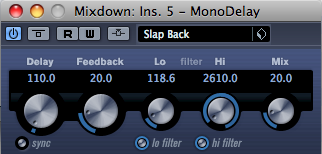In Part 1 of this series of posts dedicated to the use of delay, I have shown how to create rhythmical effects “à la U2” by synchronizing the delay to the tempo of a song. Today, in Part 2, I will first give you a few example settings showing how to fatten your tone using a Boss DD-3 and an Electro Harmonix Deluxe Memory Man. After the videos, I will explain the differences between analog and digital delays as they both have distinct sounds and when it comes to choosing a delay pedal, the analog versus digital debate is still very much alive!
Fattening your tone: the “guitar hero” delay effect
Here is a personal favorite of mine, the type of delay that countless 80s guitarists used pretty much all the time to season their fierce solos. I have reproduced it using a Digital Boss DD-3 as well as an Analog, darker sounding Electro Harmonix Deluxe Memory Man:
Gear used: American Classics Stratocaster with Kinman pickups -> Analogman TS9 -> Proco RAT 2 -> Marshall JMP-1 preamp plugged direct into the recorder
To recreate this type of delay using a software plugin or multi-effect, set a delay time around 350 ms, 3 or 4 repetitions and a mix level of about 25%. Results may vary depending on your exact equipment. As always, experiment to find out what you are most confident with and most importantly what the song you are working on exactly needs.
Fattening your tone: the slapback echo
I have written a complete post about it so I will only give the audio examples here. The slapback echo is the “mother of all delays”. It consists of only one short repetition. As simple at it may seem, it is a very effective tool as shown in this video:
Gear used: 78 Telecaster -> Proco RAT 2 -> Fender Champ
In the video, the slapback delay is generated using Cubase 5’s delay plugin with the following settings:
You can achieve the same type of tone with a Boss DD-3 and the following settings: Mode 200ms, E.LEVEL at 12 o’clock, F.BACK at 9 o’clock and D.TIME at 4 o’clock. You might want to vary the E.LEVEL or D.TIME to taste. It is easy to reproduce this effect with any other model of delay, just set the “delay time” between 70 and 200ms and the “feedback” quite low in order to have just one repeat.
Fattening your tone: Multitap delays
When one delay is not enough, use several of them! Known as “Multitap Delay”, the use of two or more delay units multiply the possibilities. Here I show the Boss DD-3 and the Electro Harmonix Memory Man together. Note that I had to reduce the delay time on the DD-3 compared to the first video, reason being that the previous settings were too close to the Memory Man and did not create enough of a swirl:
Gear used: American Classics Stratocaster with Kinman pickups -> Analogman TS9 -> Proco RAT 2 -> Marshall JMP-1 preamp plugged direct into the recorder
Again experimenting is the key here. I have used two delay settings that were quite similar but you can also use two delays with very different settings like a short one and a long one. At some stage, Joe Satriani was using three delays at once: one with a short delay time, another one with a medium delay time and a third one with a long delay time. It gave his tone almost a reverb like feeling.
The Analog vs Digital Debate
After seeing these demos you might want to go shopping for a delay pedal and must be wondering: “analog or digital?”. We have to go back in time in order to understand why there are several types of delays on the market.
Continue reading How to use a Delay, Part 2

